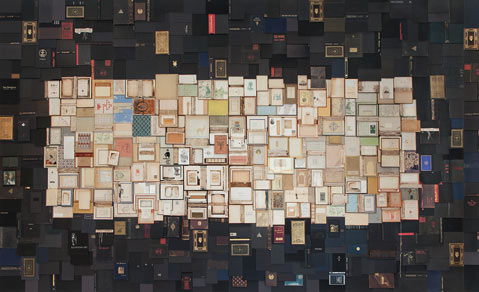Review: Requiem for the Bibliophile at MCASB
Mourning the Loss of Books, One Art Installation at a Time

Libraries, once the physical trove of a civilization’s collected knowledge and wisdom, are quickly going the way of the dinosaur. Printed books, after a 550-year run as the sacred vessel of the written word, are also fast becoming obsolete.
The finality of these statements is alluded to by the title of the show currently on view at the Museum of Contemporary Art Santa Barbara, Requiem for the Bibliophile. However, this intellectually stimulating exhibition is generally not quite as severe as the title might suggest. Most of the work here represents a self-consciously nostalgic examination of the power that books and libraries have had over the course of civilization and how current technology is upending this cultural institution. Emily Jacir’s series of photographic prints are part of a much larger installation documenting the remains of 30,000 books that were confiscated from Palestinian homes by Israeli forces in 1948. Jacir’s prints focus on the human traces left within the books by the original owners, which in turn highlight the inhumanity of denying people their written culture. Jorge Méndez Blake’s “Empty Bookshelf VII” presents the skeletal remains of the newly book-free library. It is part of a near future when we will have to decide how to reallocate these vacant public spaces.
One of the highlights of the exhibition comes from the series of artifacts collected or created by artist David Horvitz during two pilgrimages along the California coast. Horvitz’s “Local History” began with a collection of photographs of the artist standing anonymously with his back to the camera on 50 public beaches. These images were then uploaded to Wikipedia as open source documentation of each location before being removed by the website’s moderators. Having been thwarted by the newly appointed curators of the world’s largest knowledge repository, Horvitz cleverly printed and bound the documentation of his previous efforts, made his way back along the California coast, and covertly implanted his own book into the history section of every library along the way.
The other standout in the exhibition is Nancy Gifford’s not-to-be-missed “Lament.” Standing at 10 feet by 32 feet, this monumental work is jaw-droppingly beautiful, and (for the true bibliophile) equally disturbing. Created by removing the covers from antique books, the existence of the work depends upon the large-scale desecration of what many might believe to be sacrosanct. And while it is not rare for an artist to take on cultural taboos of this nature, it is rare to see it done with such finesse. The result is a powerful piece of work that must be taken in slowly, from across the room, where it can be examined in its totality, as well as up close, where the individual selection and placement of titles gains extra meaning.
Ironically, of all the pieces on display in Requiem for the Bibliophile, Gifford’s “Lament” is perhaps least deserving of that title. While so many of these artists express some level of mourning for the loss of what has until very recently been precious, Gifford’s installation most forcefully forces us to confront a future where the only appropriate emotional response to the destruction of books and the libraries that hold them is quaint nostalgia.



